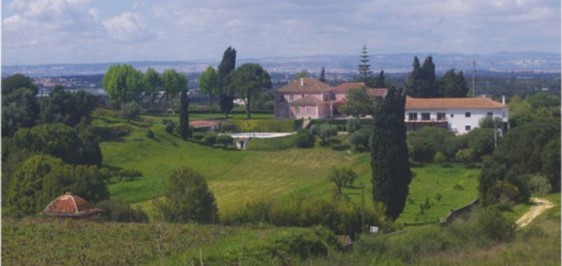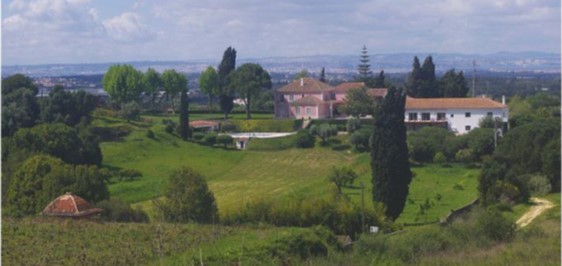A cache não está nas coordenadas iniciais! The cache is not in the given coordinates!
Esta é a cache Bónus para a Adventure Lab Conhecer a Quinta do Anjo a que pode aceder aqui: Adventure Lab Conhecer a Quinta do Anjo
This is a Bonus cache for the Adventure Lab Conhecer a Quinta do Anjo, which you can access here: Adventure Lab Conhecer a Quinta do Anjo
PT - Scroll down for English
A Fonte do Anjo
A fonte que deu o nome à quinta e mais tarde à aldeia, é uma das várias ainda existentes na encosta norte da serra do Louro, mas esta, ao contrário das outras, tem a particularidade de ter uma lenda associada e uma Casa de Fresco. Este pequeno abrigo tem no seu interior, sobre a fonte, uma inscrição em latim com esta data 1568, o que prova ser a segunda construção mais antiga, conhecida, da aldeia, a seguir aos hipogeus paleolíticos do Casal do Pardo.
A fonte é conhecida localmente por Fonte do Anjo, mas não consta do inventário das fontes do Louro e Palmela na documentação do Tombo de Palmela (COSTA, 2016, p. 480). Seria conhecida por outro nome? Não se sabe.
Segundo a obra "Palmela histórico-artística" (SERRÃO, MECO, 2007, p. 385) a fonte terá sido alvo de obras durante o séc. XVII e parte de uma escultura representando Neptuno terá sido removida por estar danificada. Os autores põe em causa se alguma vez terá existido, na construção original, a imagem do anjo referido na inscrição latina ou se terá sido a figura de Neptuno mutilada a causar a confusão. O que é certo é que o local sempre foi conhecido por Fonte do Anjo e numa carta desenhada no início do séc. XX, por altura da venda da propriedade vem mesmo a referência à existência de uma gruta do Anjo, situada entre a fonte e o solar.
Quanto à lenda permanece a dúvida: o que surgiu primeiro, a lenda ou a inscrição? O texto foi escrito por já existir no local uma lenda associada à fonte, ou é um mero exercício poético que as gerações seguintes tomaram como sendo uma lenda?
Segue a transcrição do texto original:
Irar(um) phialam diffudit fontibus olim
Angelus et rubram sanguiene fecit aquam.
Ensifer aethereis deiecit sedib(us) hostem,
Fontis adest custos angelus iste tibi.
Sic placitum antiquis tali de nomine fontem
Dicere ne pereat qui bibit eius aquam.
1568
Que pode ser interpretado como (FORTUNA, 2005, p.116) :
Um anjo derramou outrora sobre as fontes a taça das iras
e tornou a água rubra com o sangue.
O portador da espada afastou o inimigo dos assentos
etéreos, este anjo está presente para ti como guarda da fonte.
Assim aprouve aos antigos chamar à fonte com tal nome,
a fim de que não pereça quem bebe da sua água
1568
Atualmente a fonte não está acessível ao público e faz parte de uma propriedade privada

É impossível contar a história da aldeia de Quinta do Anjo sem incluir a quinta da Fonte do Anjo. A fonte do Anjo é o berço simbólico de ambas e une estes dois pólos tantas vezes em campos opostos: os nobres e o povo, os ricos e o pobres. É interessante salientar que seria a fonte a dar o nome definitivo à povoação, que durante tantos séculos foi apenas a Aldeia. E imagina-se que, quando perguntavam, mas Aldeia de quê, alguém acrescentava um nome à pressa, mas esse nome era rapidamente abandonado porque não refletia a identidade desse povo que acreditava ter um anjo a proteger as suas águas para que ninguém fosse envenenado.
Hoje a quinta permanece habitada pelos descendentes da família Velge e embora seja privada, todos os anos, abrem os portões para que a população possa visitar a antiga capela durante as Festas de Todos os Santos, a festa da aldeia que celebra o facto de ninguém ter morrido vítima do terramoto de 1755.
Texto adaptado do trabalho de Cecília Matos, que pode ser encontrado aqui: https://mediacoes.ese.ips.pt/index.php/mediacoesonline/article/view/289
PARA A CACHE: N 38° 33. (ABCx5-3) W 008° 56.(D+E-4)
AO CHEGAR AO GZ SEGUIR O TRILHO DE CIMA
EN
The Angel's Fountain - Fonte do Anjo
The fountain that gave the name to the farm and later to the village, is one of several that still exist on the northern slope of the mountain Louro, but this one, unlike the others, has the particularity of having a legend associated and a House of Fresco. This small shelter has inside, over the fountain, an inscription in Latin with this date 1568, which proves to be the second oldest known construction of the village, after the Paleolithic hypogeus of Casal do Pardo.
The fountain is known locally as Fonte do Anjo, but it is not listed in the inventory of the Louro and Palmela fountains in the National Archives at Torre do Tombo. Would it be known by another name? It is not known.
According to the work "Palmela histórico-artística" (SERRÃO, MECO, 2007, p. 385) the fountain was subject to works during the 17th century and part of a sculpture representing Neptune was removed because it was damaged. The authors question whether the image of the angel mentioned in the Latin inscription ever existed in the original construction or whether it was the mutilated figure of Neptune that caused the confusion. What is certain is that the place has always been known as Fonte do Anjo and in a chart drawn in the early twentieth century, when the property was sold, there is even a reference to the existence of a grotto of the Angel, located between the source and the manor house.
As for the legend, the question remains: what came first, the legend or the inscription? Was the text written because a legend associated with the fountain already existed there, or is it merely a poetic exercise that subsequent generations have taken to be a legend?
The transcription of the original text follows:
Irar(um) phialam diffudit fontibus olim
Angelus et rubram sanguiene fecit aquam.
Ensifer aethereis deiecit sedib(us) hostem,
Fontis adest custos angelus iste tibi.
Sic placitum antiquis tali de nomine fontem
Dicere ne pereat qui bibit eius aquam.
1568
The author Antonio Fortuna suggests the following translation (FORTUNA, 2005, p.116):
An angel once poured over the fountains the cup of wrath
and turned the water red with blood.
The bearer of the sword drove the enemy from the ethereal seats.
This angel is present for you as the guardian of the fountain.
Thus it pleased the ancients to call the fountain by such a name,
lest he perish who drinks of its water
1568
Currently the fountain is not accessible to the public and is part of private property.

It is impossible to tell the story of the village of Quinta do Anjo without including the farm of Fonte do Anjo. Fonte do Anjo is the symbolic cradle of both and unites these two poles, so often in opposing camps: the nobles and the people, the rich and the poor. It is interesting to note that it would be the fountain that would give the definitive name to the settlement, which for so many centuries was just the Aldeia (village). And one imagines that when they asked, "which village?", someone would add a name in a hurry, but this name was quickly abandoned because it did not reflect the identity of this people who believed they had an angel protecting their waters so that no one would be poisoned.
Today the farm remains inhabited by the descendants of the Velge family and although it is privately owned, every year they open the gates so that the population can visit the old chapel during the Festas de Todos os Santos, the village festival that celebrates the fact that no one died from the 1755 earthquake.
Text based on work by Cecília Matos, which can be found here: https://mediacoes.ese.ips.pt/index.php/mediacoesonline/article/view/289
TO FIND THE CACHE: N 38° 33. (ABCx5-3) W 008° 56.(D+E-4)
APPROACH THE GZ USING THE UPPER TRAIL